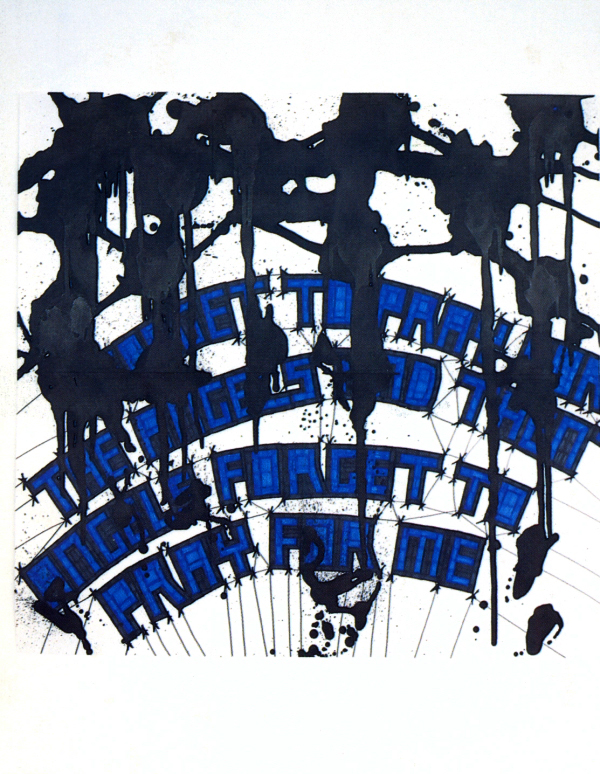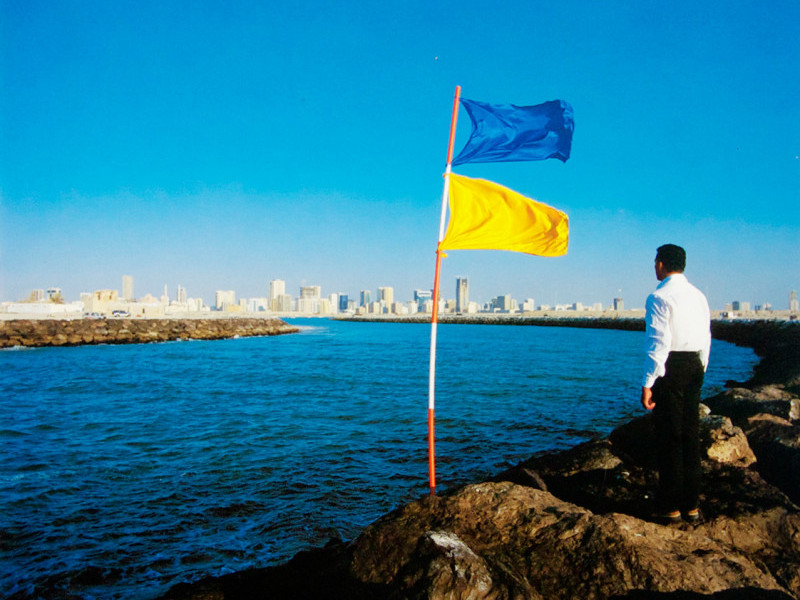
Untitled, 2002
Carsten Fock
Untitled, 2002
Felt-tip pen on paper
search


Carsten Fock
Untitled, 2002
Felt-tip pen on paper
When everything flows together in life; when reading texts and looking at images are natural activities of equal importance which play an equally important role in everyday life, without one feeling as if one were moving in different spheres of reality or norms of behaviour; then nothing could be more natural than to make use of these spheres simultaneously in art.
In the projects, T-shirts and installations by Carsten Fock, the written element; the element of language, plays a central role. The group of drawings containing writing belong to a type of work which Carsten Fock developed very early on. Felt-tip pen, coloured pencil, watercolour on paper, in formats ranging from small to large, all convey different contents and serve as social references. The eye slowly becomes aware of the letters, which are integrated into the composition, yet they do not immediately stand out as a word or a sentence but rather appear as elements of the structure as a whole, in particular, in the most recent works of the artist. The quotes from pop songs, own texts, sentences and expressions, which have either a personal or political meaning, are interwoven in such a manner that the composition of the recurring characters and frequent web-like structures develop an almost subversive power - as if they had found a new means of setting themselves in an individual context within the jungle of the countless everyday images.
The convergence of the discursive claim of Houellebecq, "The circle is the direction of movement in capitalism," portrayed in circular form, and of the frequently quoted title from the 80's song by Modem Talking, "You Can Win If You Want", leads to images with a process-like quality. Free of conformity and at the same time, embedded in the structure of the characters, the claims/statements are set in motion. In this way, the statements are not static and have at the same time lost their lack of ambiguity. In this state of instability, brought about by their open arrangement within the composition as a whole, in an experimental manner they are able to name their own environment and social reality.
The textures are applied with felt-tip, indeed often with the kind of writing strokes which best fit this pen: short, strong rows of strokes, which, in earlier works often evenly cover whole sheets of paper.
One has the impression of a continuous, flowing movement which allows the representation to be grasped quickly and which often develops a comic-like magnetic effect. The composition plays with the different means of perception which do not allow the eye to settle and this prevents even attempt at definitive fixation. This does not include the letters themselves - they change they direction of movement and colour, yet remain identical to the gesture of the stroke. In this way, the writing itself as an ordered, rational, prescribed and prescribing system is in juxtaposition to the process itself, which produces constant change. The writing thus gains a double significance. The rational, prescribed system of writing and the act of writing and drawing, which causes constat transformation, are tested in a relationship of process-oriented balanc.
The constantly expanding wealth of drawings which are set up in the exhibition rooms in transformable tableaus, are also subject to a continuous change of form repertoire which never reaches a state of completion. In later works, the architecture created at the beginning has been broken down by "outward strokes", and despite the different planes within the picture on does not have the feeling of dramaturgy. The drawings rather appear to capture a moment in the form of a "still". This is perhaps due to the fact that nothing is ever obstructing or resisting being viewed in relation to something else and can therefore be consumed as a colourful mix of styles, reminiscent of the early "flower-power" aesthetics of the 70's.
In the age of global communication technology, a cosmos of symbols surrounds us more than ever before. Computer-generated screen displays, graphic layouts and design formats influence our perception. Logos, icons and imprints have a standardising effect on our aesthetic awareness; visual perception orientates itself in a two-dimensional, space-simulating framework. Comics, fashion and media have long since left the zone of sub-cultures and have meanwhile become just as much accepted components of a visual culture. Art has naturally not been left unaffected by this and so one gladly accepts, with marked pleasure when looking at his works, that Carsten Fock makes use of these means in his drawings and pursues them as a slowly-progressing observation of society.
Britta Schmitz

Sharjah Biennial 6